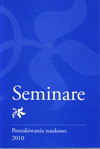The exorcistical formulae in the blessing liturgy after the council of trent
Formuły egzorcystyczne w potrydenckiej liturgii błogosławieństw
Author(s): Piotr TowarekSubject(s): Christian Theology and Religion
Published by: Towarzystwo Naukowe Franciszka Salezego (TNFS)
Keywords: the subject and object of exorcisms; people’s exorcism; objects’ exorcisms; roman ritual; blessing liturgy; after the Council of Trent
Summary/Abstract: Latin pontifical and agendas of the Middle Ages confirm a plurality of the blessing texts, a creativity of this liturgical form and, at the same time, people’s hope, which they connected with a sacrifice of people and objects. However, not always have these formulas been connected with the baptismal exorcism liturgy or the exorcisms of demented people. It turns out that they may also be found in the texts of blessing people and objects, which confirm the medieval belief of division the world into a saint and a sinful one. The sinful one needed the purification, and its absolution from sins was often related to an anti-demoniacal thinking. This way of thinking has penetrated into the liturgical books published after the Council of Trent. This article presents the genesis of the convictions mentioned above, which a famous liturgist A. M. Triacca defines as a phenomenon of “enlargement and extension” (di ingrandimento et di estensione) “subject-object” (soggetto-oggetto) of the exorcism. In ancient Christian times, this process is based on passing from exorcising people, who are catechumen and demented by evil spirit, to exorcising objects, for example: water, oil, salt (Tertulian, Orygenes, St. Hipolit, St. Augustine). This process penetrates through the medieval liturgy documents to the modern times and reaches its top in the period of realization the reform of Trent, which results in certain texts confirming the match between the blessing of objects and exorcism formulas. In that period not only are the catechumenate oil, holy anointing oil, holy water, Gregorian water or water used to bless cattle being exorcised, but also incense, bread, Easter palms, oat, radish, rue, ash, medallions and animals such as bees. The last part of the presented article also reminds about exorcisms which, in the period after the Council of Trent, accompanied the blessing of the sick and which, as well as the exorcisms of objects, penetrated to the liturgy books after the second Vatican Council.
Journal: Seminare. Poszukiwania naukowe
- Issue Year: 27/2010
- Issue No: 1
- Page Range: 29-39
- Page Count: 11
- Language: Polish

